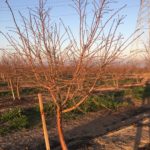
2018 almond bloom is around the corner. This year will probably be one of the earliest almond blooms we have had in Merced County. This accelerated bloom is due to the warmer, sunny weather experienced through January. Depending on conditions following flowering, hull-split and harvest should also be earlier.
Weather for the coming bloom period looks to be favorable for the San Joaquin Valley. Warm conditions (temperatures in the 70’s) and no rain in the forecast provides the conditions that are conducive for rapid flower development. Thankfully, these conditions will not favor disease. Early bloom sprays may not be needed for many tolerant varieties (e.g. Nonpareil), unless heavy dew and susceptible varieties (i.e. Butte) are present.
Regardless of weather, a fungicide spray made at full bloom/petal fall should be considered. This fungicide should provide protection for brown rot, shot-hole and jacket rot. Of these three, jacket rot is one of the harder fungi to control with the modern fungicide chemistries as the strobilurins (FRAC 11) and DMIs (FRAC 3) are not effective. This spray timing will provide protection for any rain events that would occur within two weeks of application. Successive in-season sprays may be needed if the weather turns wet. Further information reagrding fungicide timing and efficacy can be found here: http://ipm.ucanr.edu/PDF/PMG/fungicideefficacytiming.pdf .
Fungicide applications should be made at a time of day to reduce bee exposure. Applications later in the day will reduce exposure as bee foraging is decreased in the afternoon. If applying at night, allow enough time for the fungicide dry before bee foraging begins the next day. Also, avoid any addition of surfactants with the fungicide unless directed by the fungicide label. Many more management practices for bees can be found at The Almond Board of California’s website: http://www.almonds.com/pollination .
The first irrigation will be tricky to time in 2018. The lack of winter rainfall has reduced the amount of moisture in the soil profile. This will be further compounded by the earlier development of the tree, leading to an increase in early season water use in comparison to previous years. Use of the pressure chamber or soil moisture probes should be utilized to determine when to begin irrigation. Irrigating now to attempt to refill the soil profile is not advised as it may create anaerobic conditions within the root-zone during the critical time of bloom.


Robert Driver
March 6, 2018David,
What levels of damage have you seen in regard to these last 10 days of freezing temperatures starting on the morning of Tuesday, February 20, 2017. Here is a compilation of our TempAlert orchard sensor log for that period: Hours below these temperatures: 53.25 below 32; 41.00 below 31; 21.75 below 30; 11 below 29; 6 below 28; 3.75 below 27; 2.50 below 26; and finally 1.25 below 25. We are really cold here on Tim Bell Road, in the Paulsel Valley 5 miles north-east of Waterford. Miraculously we have seen very little freeze damage. Our variety is Independence, 6th and 7th leaf, fully watered with micro-sprinklers, every time the TempAlert sensors went below 34 degrees, with the caveat that these temps were from within the orchards while the sprinklers were running. We cut ovaries almost every day – and, so far our damage looks like it is only one or two nuts here and there (much less than 1%). Why? When we are hearing that other growers are reporting 80-85% damage. Is Independence more hardy? We don’t know – but I have observed that the nectariferous tissues are quite thick walled and lined with an abundance of orange colored nectar. There also appears to be a very large air-cushion between the its walls and the ovary. Then, after fertilization, the enlarging ovule appears to have an abundance of pubescence covering the developing nut. Have you noticed these things in your observations? Finally, whatever the outcome of this unprecedented frost season – we will trust in God.
David Doll
March 8, 2018Hey Bob,
Thanks for sharing your observations. I am glad to hear that you made it through the freeze event. Many others havent been so fortunate (for all varieties, including Independence).
To answer your questions: we dont know. The University was told by the breeding company that we weren’t allowed to do any comparative testing with Independence. In general, all varieties have differences in their critical temperatures for different stages. Some varieties can tolerate 26F at full bloom without much damage while others will have significant losses. Add to this the gains in orchard temperature with frost protection strategies. If flows were high enough, running water with microsprinklers could increase temperatures within the orchard by 2-3 degrees. Full canopied trees are also able to trap more heat.
If water was ran and temperatures dropped to 1-2 degrees below critical temperature, the microspinklers might have provided enough warmth that kept the flowers above the critical temperature. All of the characteristics you mention do help increase the heat of the micro-climate around the ovary, adding some protection…but again, it is hard to know how this variety compares to others.
I have also heard of the high losses you are reporting. It seems many of those orchards were either in cold air sinks or were irrigated with drip. Drip Irrigation doesn’t provide much frost protection (if any) due to the inability to mist the water into the air.
Sorry I am not much help on this one.
David